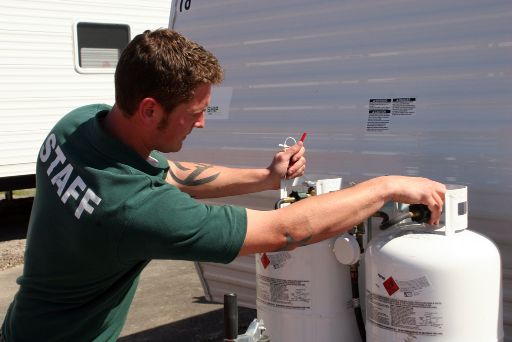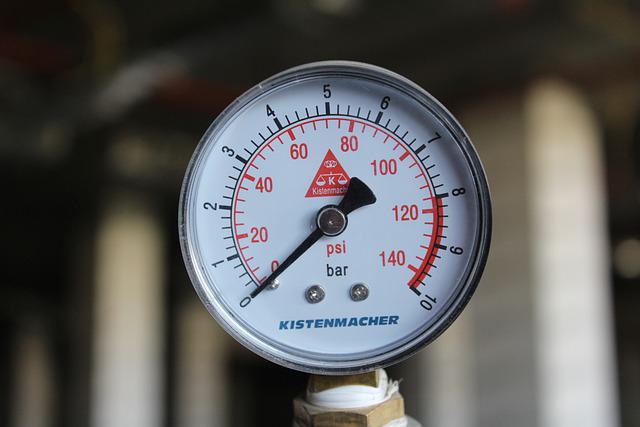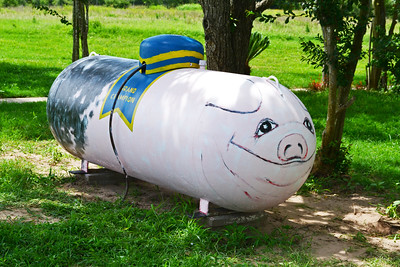
It is not recommended to drive over a buried propane tank. Here’s why:
- Risk of Damage: Propane tanks, even when buried, are not designed to withstand the weight and pressure of a vehicle. Driving over one could potentially damage the tank’s structure, leading to leaks or more catastrophic failures.
- Potential for Undetected Leaks: Even if a tank does not visibly rupture when driven over, there’s a risk of small, undetected leaks. These leaks could result in propane buildup, which can be dangerous and potentially explosive.
- Depth of Burial: While underground propane tanks are typically placed below the frost line to prevent freezing, this depth might not be enough to protect them from the weight of a heavy vehicle.
- Soil Movement: The weight and movement of a vehicle could shift the soil around a tank, potentially leading to uneven pressure points or disrupting connections and fittings.
- Safety First: Propane is a flammable gas, and even a small spark can ignite it. If there’s any leak or release of propane caused by driving over the tank, it can pose a significant fire hazard.
For these reasons, areas with propane tanks should be clearly marked, and vehicle traffic should be kept away. If there’s any suspicion that an underground propane tank has been damaged, it’s crucial to call professionals for an inspection immediately.
Understanding the Construction & Strength of Buried Propane Tanks
Buried propane tanks are specifically constructed to be placed underground, and their design takes into account the various challenges posed by the subterranean environment.
- Typical Materials Used in Their Construction
- Steel: Most propane tanks are made primarily of steel, which offers the strength and durability needed to contain pressurized propane. The steel used in propane tanks is thick and designed to withstand both internal pressures from the stored gas and external pressures from the surrounding environment.
- Corrosion-resistant Coatings: Given that these tanks are buried, they are exposed to moisture and soil-based corrosives. To counteract this, the outer surface of the tank is coated with special corrosion-resistant materials to prolong their life and prevent leaks.
- Design for Withstanding External Pressures
- Shape: The cylindrical shape of propane tanks helps evenly distribute the internal pressure of the stored gas. This shape, combined with the strong steel construction, also helps the tank resist external pressures.
- Pressure Relief Valves: Tanks are equipped with pressure relief valves that are designed to release propane in a controlled manner if the internal pressure becomes too high. This serves as a safety measure to prevent over-pressurization and potential tank rupture.
- Burial Depth: The recommended burial depth considers the weight of the soil and potential external pressures. Being underground below the frost line also helps to maintain a consistent temperature, which prevents extreme fluctuations in internal gas pressure.
Potential Dangers of Driving Over a Buried Propane Tank
- Risk of Damaging the Tank’s Structure
- While propane tanks are robust, the weight of a vehicle, especially heavy ones, can cause deformations or even rupture the tank. This damage may not be immediately visible but can compromise the integrity of the tank over time.
- Possibility of Causing an Undetected Leak
- The pressure exerted by a vehicle can cause small fissures or dislodge fittings, leading to slow leaks. Such leaks may go unnoticed initially but can pose significant dangers as the escaping propane accumulates.
- Threat of Igniting the Gas if There’s a Spark
- If a tank is damaged and leaking, any spark—caused by static electricity, a dropped tool, or even the vehicle itself—can ignite the propane. Given that propane is heavier than air, it can pool in low-lying areas, increasing the risk of an explosion if ignited.
Factors That Influence the Safety of Driving Over a Buried Tank
- Depth at Which the Tank is Buried
- A tank that’s buried deeper is generally safer from surface pressures. The recommended burial depth not only helps in temperature regulation but also provides a buffer against external pressures, including those exerted by vehicles.
- The Type of Vehicle Being Driven Over the Tank
- Light vehicles such as small cars and bicycles might not exert as much pressure as larger vehicles like trucks or SUVs. However, repeatedly driving any vehicle over a buried tank increases the risk of damage.
- The Condition and Age of the Propane Tank
- As tanks age, they can corrode, especially if not coated with corrosion-resistant materials. Older tanks or those in disrepair are more vulnerable to damage when driven over.
- Soil Conditions and Their Potential Impact on Tank Stability
- Sandy or loose soils may not provide as much support as compacted or clay-rich soils. In unstable soil conditions, the weight of a vehicle can shift the tank or apply uneven pressure, increasing the risk of damage.
Preventative Measures and Best Practices
- Ensuring a Proper Burial Depth for the Tank
- Adhering to recommended burial depths provides an added layer of protection. It’s essential to consult with propane tank installation professionals to ensure the tank is buried at an appropriate depth for your region and soil type.
- Marking the Area Where the Tank is Buried to Avoid Accidental Driving
- Clearly marking the boundaries where the tank is buried helps prevent inadvertent driving over the area. This can be achieved using landscaping features, signs, or physical barriers.
- Regular Inspections to Ensure the Tank’s Integrity Isn’t Compromised
- Regularly scheduled inspections by professionals can identify potential issues before they become significant problems. This includes checking for signs of corrosion, damage, or leaks.
- Recommendations for Landscaping and Driveway Designs to Avoid Driving Over the Tank
- Design outdoor spaces with the propane tank’s location in mind. Avoid constructing driveways or parking areas over buried tanks. Landscaping can be used both as a marker and a deterrent, with features like raised flower beds, shrubs, or decorative rocks indicating where the tank is located.
What to Do If You Suspect Damage to Your Buried Propane Tank
Realizing that your underground propane tank might be damaged can be distressing. Here’s a step-by-step guide on what to do:
- Immediate Safety Precautions
- Evacuate the Area: Ensure all individuals, including pets, are away from the suspected damaged area.
- Avoid Ignition Sources: Turn off all open flames, including grills, candles, and stoves. Do not smoke, and avoid using light switches or electrical appliances, as they can create sparks.
- Ventilate: If you smell gas or suspect a leak inside your home, open windows and doors to allow fresh air in and dissipate the gas.
- Do Not Drive Vehicles Near the Area: Starting a vehicle near a potential gas leak can lead to ignition.
- Steps for Checking the Integrity of the Tank
- Smell: One of the first signs of a propane leak is the smell. Propane has a strong, unpleasant smell, like rotten eggs or a skunk, added specifically to detect leaks.
- Listen: A hissing sound can be an indicator of gas escaping from the tank.
- Check for Dead Vegetation: Propane leaks can cause vegetation above or near the leak to die, so if you notice a patch of dead or discolored grass or plants, it may be a sign of a leak.
- Do Not Dig or Probe the Ground: If you suspect damage, avoid digging around the tank or probing the ground, as you could inadvertently cause more damage or spark ignition.
- Importance of Calling Professionals for a Thorough Inspection
- Expert Assessment: Professionals have the tools, knowledge, and experience to assess the situation accurately. They can conduct pressure tests, use leak detection equipment, and evaluate the structural integrity of the tank.
- Safety First: A damaged propane tank can be a significant hazard. Even if you think the damage is minor, it’s always safer to have a professional give the all-clear.
- Possible Repairs or Replacement: If damage is confirmed, professionals can guide you on the necessary repairs or even replacement if the damage is extensive.
- Peace of Mind: Knowing that a professional has inspected and declared your propane tank safe provides peace of mind.
If you suspect any damage to your propane tank, always prioritize safety and seek professional assistance immediately.
For more information, read OSHA requirements in the installation of it.
Bobtail Driver Usually Doesn’t Realize the Situation
If you notice a bobtail driver or any other vehicle driving over your buried propane tank, it’s essential to approach the situation with caution and diplomacy. Here’s a suggested course of action:
- Stay Calm and Polite: Remember, the driver may not be aware of the tank’s location, or they might be following procedures they believe are correct. Approach them without confrontation.
- Signal the Driver: If it’s safe to do so, signal the driver to stop the vehicle immediately. Use hand signals and ensure you’re visible but at a safe distance.
- Inform the Driver: Once the vehicle has stopped, approach the driver and let them know about the buried propane tank. Say something like, “Excuse me, there’s a buried propane tank right here. Driving over it can pose risks. Can we ensure vehicles avoid this area in the future?”
- Use Markers in the Future: To prevent such occurrences, consider using more visible markers or barriers around the area of the buried tank. This can help guide drivers and prevent unintentional driving over the tank.
- Document the Incident: Make a note of the date, time, and any potential damages you might observe. It’s crucial to keep a record in case any issues arise later.
- Contact the Propane Company: Report the incident to your propane provider. They can provide guidance on checking the tank for damage and can also offer training or reminders to their drivers to avoid such incidents in the future.
Remember, most drivers and workers want to do their job safely and correctly. A polite reminder and clear communication can go a long way in ensuring the safety and longevity of your buried propane tank.
FAQs
1. Are buried propane tanks safe? Yes, such propane tanks are safe when installed, maintained, and inspected properly. They are specifically designed for underground placement, with protective coatings to prevent corrosion. Regular inspections and adhering to safety guidelines further ensure their safe operation.
2. Can a propane tank go under a driveway? It is generally not recommended to place a propane tank directly under a driveway. The constant pressure and weight from vehicles could potentially damage the tank or its connections. If a tank must be near a driveway, it should be adequately reinforced, or barriers should be used to prevent direct vehicular traffic over it.
3. Is it illegal to drive around with a propane tank? Driving with a propane tank is not illegal, but there are regulations and safety guidelines to follow. Tanks should be upright, secure, and in a well-ventilated area (like the bed of a pickup truck). Avoid leaving a tank in a closed vehicle for an extended time, especially in hot weather, due to the risk of increasing pressure inside the tank.
4. How deep is an underground propane tank? The depth at which an underground propane tank is buried varies, but they are typically buried at a depth that places the top of the tank 6-18 inches below the surface. The exact depth can depend on the local climate (to be below the frost line), tank size, and local regulations.
5. How long do buried propane tanks last? The lifespan of such a propane tank can vary based on factors like the quality of its construction, the protective coatings used, soil conditions, and maintenance practices. However, on average, a propane tank can last between 20 to 30 years. Regular inspections and maintenance can help ensure a tank reaches or exceeds its expected lifespan.
6. How close to the house can a buried propane tank be? Regulations on how close a propane tank can be to a house or structure can vary based on local codes and the size of the tank. Generally, larger tanks (over 500 gallons) require a greater distance from structures and property lines, often around 10 feet or more. Smaller tanks might have shorter distance requirements. Always check with local regulations and consult with propane installation professionals to ensure safe and compliant placement.
To Make a Conclusion
Driving over a buried propane tank, regardless of its robust construction, poses significant risks that can lead to hazardous situations. From the potential of causing structural damage to the tank, to the grave danger of igniting leaked gas, the stakes are undeniably high. The very design and burial of these tanks account for numerous factors, but vehicular pressure is not one they’re generally equipped to handle safely.
Being aware of the tank’s location is more than just good practice; it’s a responsibility. Whether it’s marking the area, adapting landscape designs, or simply sharing the information with family and visitors, every effort counts. In the realm of propane tanks, as with many things in life, it’s always better to err on the side of caution.
In essence, prioritize safety first, always. Remember the potential consequences before driving over or near a buried propane tank. Your awareness and precautionary actions not only protect your property but, more importantly, can save lives.

Mike is an experienced propane technician with over 15 years of professional experience in the field. He has dedicated his career to helping customers with their propane needs, from installation to maintenance and repair. Together with Jeremy, he co-founded this website to provide useful information and guidance to customers seeking reliable propane services.



